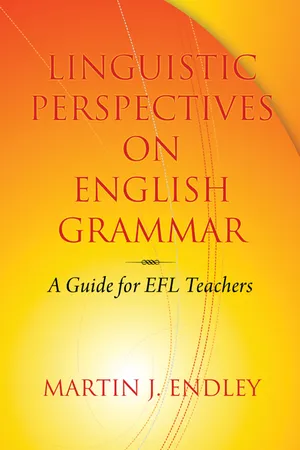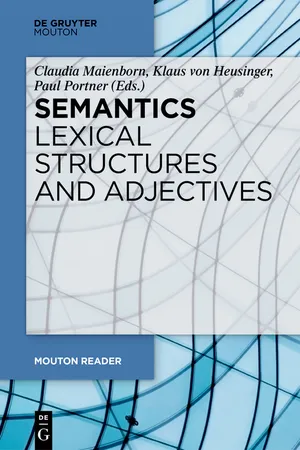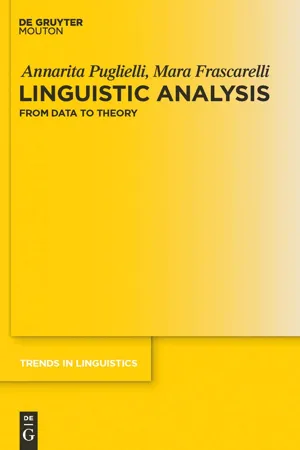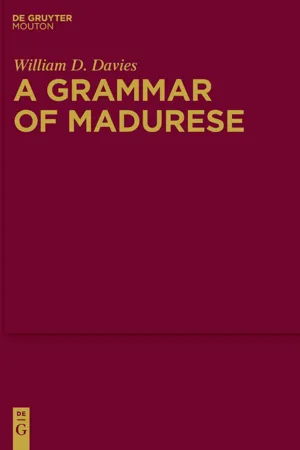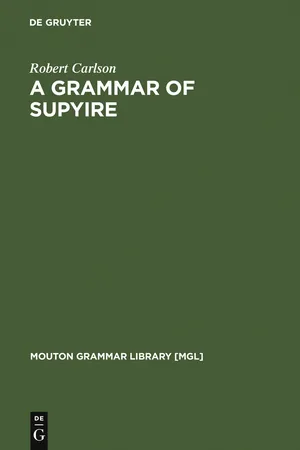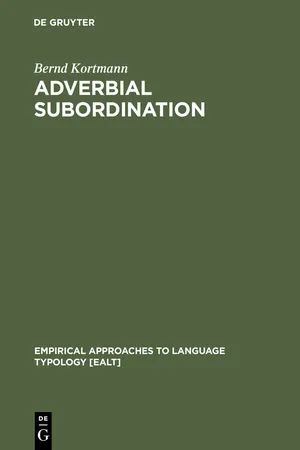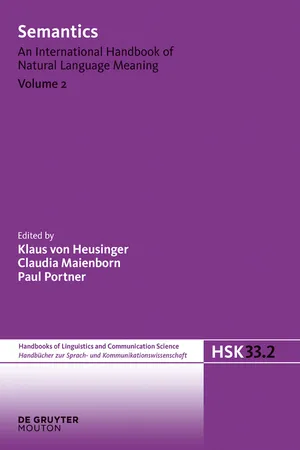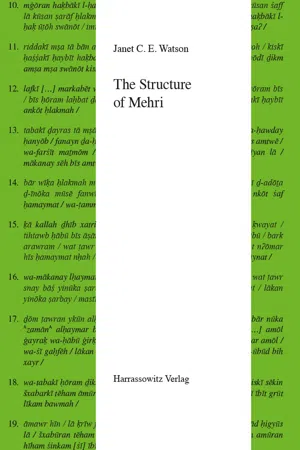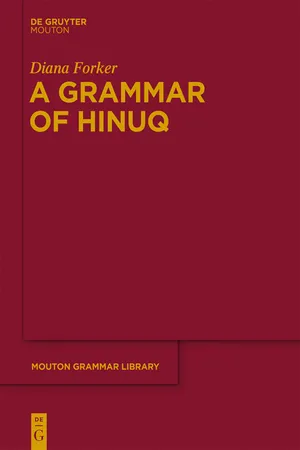Languages & Linguistics
Adverbial Clause
An adverbial clause is a group of words that functions as an adverb in a sentence. It provides information about time, place, manner, condition, purpose, or reason. Adverbial clauses often begin with subordinating conjunctions such as "when," "where," "how," "if," "because," and "although." These clauses can modify verbs, adjectives, or other adverbs in a sentence.
Written by Perlego with AI-assistance
Related key terms
1 of 5
10 Key excerpts on "Adverbial Clause"
- eBook - PDF
- Martin J. Endley(Author)
- 2007(Publication Date)
- Information Age Publishing(Publisher)
Linguistic Perspectives on English Grammar, pages 431–457 Copyright © 2010 by Information Age Publishing All rights of reproduction in any form reserved. 431 12 Complex Sentences in English Adverbial, Participial, and Conditional Clauses In Chapter 3, I distinguished between adverbs (aggressively, happily, quickly, etc.) and other types of expressions that serve an adverbial function. I noted that both phrases and clauses can also serve adverbial functions. Adverbial phrases were covered in Chapter 4 in looking at the role of prepositions. In this final chapter, I will consider certain constructions that feature Adverbial Clauses. I begin my discussion by considering in general terms what the adverbial function involves, identifying some of the main semantic subtypes of Adverbial Clauses. I then turn to a somewhat more detailed consideration of one particular set of adverbials, namely participial clauses. However, the bulk of this chapter is devoted to a detailed examination of one of the most linguistically interesting and, it must be said, pedagogically challenging ad- verbial constructions, the conditional construction. 432 Linguistic Perspectives on English Grammar The Adverbial Function in English: An Overview Adverbial Clauses serve as optional modifiers within a sentence. Just as ad- verbs modify verbs (among other things), Adverbial Clauses modify another clause. Their parallel function is suggested by the fact that frequently a single-word adverb and an Adverbial Clause will be interchangeable. This is the case in (1). (1) a. I’ll talk to you later. b. I’ll talk to you when my meeting is over. In (1a), the form later is a temporal adverb; in (1b), the clause when my meeting is over is a temporal Adverbial Clause. As with adverbs, Adverbial Clauses constitute a heterogeneous group— a fact that makes their description somewhat tricky. As clauses, adverbials contain a subject and a verb. - Claudia Maienborn, Klaus von Heusinger, Paul Portner(Authors)
- 2019(Publication Date)
- De Gruyter Mouton(Publisher)
https://doi.org/10.1515/9783110626391-015 Kjell Johan Sæbø 15 Adverbial Clauses 1 Introduction 515 2 Temporal clauses 516 3 Modal clauses 524 4 Instrumental and free adjunct clauses 533 5 Conclusions 538 6 References 540 Abstract: Adverbial Clauses are subordinate clauses that modify their superordi-nate clauses. This modification can occur at various levels (such as verb phrase, tense phrase, mood phrase) and in various dimensions (such as times and worlds) and ways. These variations give rise to a categorization of Adverbial Clauses (tem-poral, modal, ...) and a subcategorization according to a range of relations within these dimensions, depending on the subjunction. Thus within the modal category it is customary to distinguish between causal, conditional, purpose, result, and concessive clauses. Sometimes the subjunction does not seem to encode much meaning of its own and the clause acts more like a relative clause, modifying a quantificational adverb or a modal, or specifying an underspecified predicate; sometimes, when there is no subjunction (“free” adjunct clauses), the contribu-tion of the clause is underspecified. 1 Introduction Adverbial Clauses are a proper subclass of the class of all adverbials. To a considerable extent, this subclass relation distributes over the major semantic categories of adverbials commonly identified (see article 14 [this volume] (Maienborn & Schäfer) Adverbs and adverbials) . Thus in the temporal category, there are closely comparable clausal and nonclausal adverbials, e.g.: “since Benitez arrived at Anfield” - “since June 2004”. Locative adverbials and manner adverbials tend to be nonclausal, but instrumental adverbials can be both: “by hammering it” - “with a hammer”. In the modal category, clausal adverbials predominate; there are no close counterparts to conditional or causal clauses in the form of (nonanaphoric) adverbs or prepositional phrases. Kjell Johan Sæbø, Oslo, Norway- eBook - PDF
Linguistic Analysis
From Data to Theory
- Annarita Puglielli, Mara Frascarelli(Authors)
- 2011(Publication Date)
- De Gruyter Mouton(Publisher)
5.5.1. The internal syntax of Adverbial Clauses In the literature, the subordinating element of an Adverbial Clause is usually ascribed to the category of complementizers (i.e. C° heads; see Grimshaw Adverbial modification 202 1991, Lasnik & Saito 1992, Vikner 1994). However, cross-linguistic data show that this type of introductory element should not be considered to be equivalent to an invariable functional head as a complementizer (e.g. English that, Italian che, German dass, etc.) but as an element having nominal properties. Let us now present some data on time and manner Adverbial Clauses from typologically different languages, starting with Somali, an inflecting and partly polysynthetic language (from Frascarelli & Puglielli 2005a): (56) a. Gaba-rtii oo [mar-kaas gur-iga gashay] girl-DET.AN ASSOC time-DEM house-DET enter.PST.RED baan arkay. (SOMALI) FM.SCL.1SG see.PST.1SG ‘I saw the girl after she had walked into her house.’ b. [In-t-aad shaqeemaysó] buug baan part-DET-PRO.2SG work.PROG.DEP book FM.SCL.1SG akhrinayaa. read.PROG.1SG ‘While you are working, I am going to read a book.’ c. [Goorta qorra-xdu dhacdó] imaw. momentDET sun-DET.NOM set.DEP come.IMP.2SG ‘Come when the sun sets.’ d. [Si-da Ahmed uu doonayó] erey-ga u way-DET Ahmed SCL.3SGM want.PROG.DEP word-DET to qor. write.IMP.2SG ‘Write the word the way Ahmed wants.’ First of all, it should be noted that the introductory element of subordinate clauses (corresponding to English conjunctions after, when, while and the way [that]) is a noun, as it can be modified by a DET or a DEM and can be used in sentences with a subject or object function. Such nouns are usually generic (‘time’, ‘moment’, ‘manner’, etc.); however, a certain degree of subcategorization can be observed, relating to a specific type of (adverbial) temporal modification: Mar for posteriority, in and goor for simultaneity (the former with a durative aspect, the latter with a punctual one). - eBook - PDF
- William D. Davies(Author)
- 2010(Publication Date)
- De Gruyter Mouton(Publisher)
Chapter 12 Adverbs and Adverbial Clauses Adverbial expressions elaborate information regarding the state of affairs expressed by the verb and its arguments, information such as temporality, frequency, manner, purpose, instrumentality, and so on. This chapter details lexical, phrasal, and clausal adverbial expressions. 1. Types of adverbial expressions Few lexical items exist that one can unequivocally identify as adverb roots. However, there are many nouns and adjectives that function adverbially and there are some derived lexical items that function adverbially. These include temporal, frequency, epistemic, manner, and degree expressions. 1.1. Temporal expressions Expressions of time are largely nominal and adjectival. Nominal expressions include: nouns denoting time of day, e.g. laggu ‘ morning ’ , seyang ‘ midday ’ , malem ‘ night ’ , nouns denoting specific days, e.g. ba'ari' ‘ yesterday ’ , laggu' ‘ tomor-row ’ , dhaggu' ‘ tomorrow ’ , nouns denoting periods of time, e.g. jam ‘ hour ’ , are ‘ day ’ , bulan ‘ month ’ , taon ‘ year ’ , names of days of the week, e.g., are Minggu ‘ Sunday ’ , are Salasa ‘ Tuesday ’ , names of months and years, e.g. bulan Juni ‘ June ’ , bulan Augustus ‘ August ’ , taon sa'ebu sangatos sabidak lema' ‘ 1965 ’ , taon dhu'ebu set-tong ‘ 2001 ’ , and specific times and dates, e.g., kol lema' ‘ five o ’ clock ’ , tangal tello polo Juni dhu'ebu ballu' ‘ 30 June 2008 ’ Examples of these are given in (1-3). 390 Chapter 12 Adverbs and Adverbial Clauses (1) Daddi baji' gella', e-soso-we kerbuy pote pan-brampan are so baby before OV -milk-LOC buffalo white RED -how.many day dha' iya iya like.this yes ‘ So the baby was nursed by the albino buffalo for several days like this. ’ (2) Engko' malem-ma a-mempe se ne-banne . I night-DEF AV -dream REL RED -no ‘ Last night I dreamed something weird. ’ (3) Taon sa'ebu sangangngatos sabidak ennem koca'-eng mo'dul pole . year 1000 900 60 6 say-DEF show.up again ‘ In 1966 they say it appeared again. - eBook - PDF
- Robert Carlson(Author)
- 2011(Publication Date)
- De Gruyter Mouton(Publisher)
15.1. A dverbial cla uses 549 Chapter 15 Interclausal connections This chapter describes the types of interclausal connection which have not been covered in previous chapters. As might be expected for a category de-fined negatively in this way, the clause types described here are extremely varied both in form and function. They can however be broadly separated into two groups: Adverbial Clauses and coordinate clauses. It should be stated at the outset that Adverbial Clause is used only as a convenient functional label. There is no set of structural correlates serving to define the clauses gathered under the term in the way there is for relative clauses or verb complements. Just as adverbs are an eclectic mix of various subtypes of words which do not fall obviously into more homogenous classes, the clauses treated here as adverbial vary widely in both structure and function. Structurally, coordinate sentences are not such a mixed bag as the adver-bial clauses. Simple juxtaposition of clauses as well as contrastive and alter-native coordination are covered briefly in section 1S.2 below. The more elaborate system of clause chaining is dealt with in the final section, 15.3. 15.1. Adverbial Clauses Adverbial Clauses are classified here in terms of their semantic function. It would also be possible to classify them by their form. Using a parameter such as relative degree of integration of the subordinate clause into the main clause would yield a scale ranging from highly integrated nominalized clauses to all but independent indicative clauses. An example of the former is the nominalized manner Adverbial Clause in the following sentence, which functions syntactically as an indirect object: (1) U a kwH ήάέ kwü-jjkäni na τηύ. - eBook - PDF
Complex Structures
A Functionalist Perspective
- Betty Devriendt, Louis Goossens, Johan van der Auwera, Betty Devriendt, Louis Goossens, Johan van der Auwera(Authors)
- 2011(Publication Date)
- De Gruyter Mouton(Publisher)
The main division here concerns the pre-supposedness of the Adverbial Clause. Secondarily, and within the class of nonpresupposed second order entities only, a division is made between clauses with dependent and those with independent time reference. Structure of Adverbial Clauses 133 6. The expression of Adverbial Clauses 6.1. Introduction In order to demonstrate the validity of the parameters distinguished above, I will now turn to a typological investigation of the expres-sion of Adverbial Clauses. 5 6.2. The sample All typological observations made in this paper are based on a sam-ple of 25 European languages, which were selected according to the method described in Rijkhoff et al. (1993). The languages are dis-tributed across the European phyla as indicated in Table 2. For two extinct phyla, ETRUSCAN, and OSCO-UMBRIAN, no data could be obtained. As a result, the actual sample contains 23 languages.6 6.3. Finiteness and nonfiniteness of Adverbial Clauses 6.3.1. Introduction For each of the sample languages, data were collected with respect to the form the subordinate verb takes in the various types of adverbial construction discussed earlier. Paratactic realizations of interclausal relations were excluded. Here I will restrict myself to the finite and nonfinite realization of the subordinate verb. Figure 3 will serve as my point of departure for presenting the typological data. This figure contains three parameters, which represent three typological hierar-chies. The parameter represented horizontally, which concerns the type of entity the Adverbial Clause refers to, is of crucial interest to the question raised in this paper concerning the validity of the vari-ous layers recognized within the hierarchical structure of the clause, since the entity types which make up this parameter each correspond with a particular layer. However, since this parameter interacts cru-cially with the remaining two, it cannot be studied in isolation. - eBook - PDF
Adverbial Subordination
A Typology and History of Adverbial Subordinators Based on European Languages
- Bernd Kortmann(Author)
- 2012(Publication Date)
- De Gruyter Mouton(Publisher)
Evidently, these obstacles are even greater and more numerous in a typological study than they are in a single-language account. 4.2.1.1. The subordination — coordination continuum The first major problem emerges from the two prototype definitions given in the previous section: prior to a definition of what is an adverbial subordinator one needs to define what is a subordinate clause. Not rarely, however, subordina-tion is defined, directly or indirectly, by means of the presence of an adverbial 4. Data collection and classification 57 subordinator. This danger of circularity can clearly be observed, for example, in the following definition of Adverbial Clauses in English: Adverbial Clauses ... are introduced by a subordinator, i. e. a subordinating conjunctional or some other functional [sic] which can introduce a subordinate clause. It is true that many adverbials, e.g. briefly, honestly, being a stranger, can be turned into clauses ..., but they are not introduced by a subordinator and are accordingly classified not as clauses but as adverbs or adverbial phrases (Jacobson 1964: 21). While Jacob-son goes as far as making the presence of an adverbial subordinator the neces-sary and sufficient condition for a clause to qualify as an Adverbial Clause, circu-larity comes in more indirectly in Thompson's (1984) discussion of (finite) adver-bial clauses. Trying to avoid the notion of subordination, she defines Adverbial Clauses rather as clauses which are formally 'dependent', in the sense that they ... must occur with some other clause (1984: 88). Then, however, she lists as crucial indicators of formal dependency such connectors for adverbial ad-juncts like while, i f , because, so that, as i f , etc., i. e. the whole array of adverbial subordinators in English. - eBook - PDF
- Klaus von Heusinger, Claudia Maienborn, Paul Portner, Klaus von Heusinger, Claudia Maienborn, Paul Portner(Authors)
- 2011(Publication Date)
- De Gruyter Mouton(Publisher)
Several subjunctions do double duty in the sense that they underspecify the semantic relation they encode - they correspond to two (or more) subjunctions in another lan-guage. For example, English “when” can be universal or existential in the past or future; German “wenn” can be conditional or temporal (universal or existential in the future). This attests to (1) the interrelatedness of the temporal and the modal dimension (also indicated by the use of past forms in counterfactual environments, cf. Iatridou 2000), and (2) the role of the context of utterance in clarifying what relation is meant by a certain Adverbial Clause. So what are, again, Adverbial Clauses - is a common characterization so vague as to be vacuous? Probably not; for one thing, they differ from other adverbials in utilizing the same kind of material they serve to modify (basically, things that clauses can express); and second, they differ from other subordinate clauses in carrying a more or less complex and specific semantic relation on their own, - even when the relation is, by itself, highly unspecific, contextual and pragmatic factors conspire to narrow it down. 6. References Abbott, Barbara 1974. Some problems in giving an adequate model-theoretic account of CAUSE. In: C. Fillmore et al. (eds.). Berkeley Studies in Syntax and Semantics 1 . Berkeley, CA:, University of California, 1–14. Anscombe, Gertrude E. M. 1957. Intention . Oxford: Blackwell. Anscombe, Gertrude E. M. 1964. Before and after. The Philosophical Review 73, 3–24. Aristotle. Metaphysics . Quoted from The Perseus Digital Library. http://www.perseus.tufts.edu/ hopper, August 9, 2011. Asher, Nicholas 1993. Reference to Abstract Objects in Discourse . Dordrecht: Kluwer. Beaver, David & Cleo Condoravdi 2003. A uniform analysis of before and after. In: R. Young & Y. Zhou (eds.). Proceedings of Semantics and Linguistic Theory (= SALT) XIII . Ithaca, NY: Cornell University, 37–54. - eBook - PDF
- Janet C. E. Watson(Author)
- 2014(Publication Date)
- Harrassowitz Verlag(Publisher)
9 Supplementation Adverbs modify adjectives, verbs, clauses and other adverbs. Adverbs and adverbials differ syntactically from complements in that they are supplementary and are not required to complete the proposition, they are less tightly bound to the modified element than complements, and many adverbs are not restricted to a particular position in relation to the modified element. In Mehri, there are a few words and particles that function solely as adverbs (cf. 2.8). These include some adverbs of time and degree ending in -an , -a ( h ) or -ō h , such as ḥā w ē lan ‘earlier’, ī m ō h ‘today’, n ṣ ar ō mah ( ṣ ar ō mah ) ‘now’, w ī yan ~ w ī ya ‘very; much’; 1 adverbial particles such as b ā r , ʕā d ( ā d ) and ā r ; and interrogative adverbs such as mayt ( an ) ‘when’, h ī b ō h ‘how’, kam ‘how much, how many’, wk ō h ‘why, how’. In particular contexts, NPs and, more commonly PPs, function adverbially. Adverbial Clauses are introduced by adjunctions, by wa - in the case of circumstantial clauses, or paratactically. In this chapter, I examine the syntax of adverbs and adverbial phrases within simplex clauses and then the syntax of Adverbial Clauses. 9.1 Adverbs 9.1.1 Adverbs of time The largest number of adverbs come under the category of adverbs of time. Adverbs of time can be subcategorised into those denoting a point or period in time, such as ‘in the morning’, ‘last year’, those denoting a boundary in time before or after which an event or state occurred, such as ‘afterwards’, ‘beforehand’, those denoting the duration of a state or event, such as ‘for two days’, ‘a whole year’, and those denoting the frequency of an event, such as ‘once’, ‘never’ (cf. Quirk & Greenbaum 1973: 229–230). They include the specific adverbs listed in chapter 2 (tables 81, 82), and adverbial phrases formed from PPs and NPs relating to time, such as the time and days of the week. - eBook - PDF
- Diana Forker(Author)
- 2013(Publication Date)
- De Gruyter Mouton(Publisher)
Chapter 21 Adverbial Clauses 21.1. Introduction In Adverbial Clauses mostly converbs but also participles are used. They express temporal and non-temporal circumstances that serve as the background for the action or situation described in the main clause. The morphological make-up and the meaning of all converbs and participles used in Adverbial Clauses are treated in Sections 7.7.2 and 7.7.3. In this chapter, the syntactic properties of Adverbial Clauses are analyzed, including reference, control, scope, word order, and extraction properties. 21.2. Coreference and control 21.2.1. Coreference and pragmatic connectedness In Hinuq converb constructions, there are no coreference or disjoint reference constraints for arguments of converbal clauses, as is typical of Nakh-Daghesta-nian languages (see Haspelmath (1995a) on Lezgian, Creissels (2010c) on Akh-vakh, and Comrie et al. (2012) on Tsezic languages in general). With the ex-ception of some examples involving the Narrative converb as in (1051a) below, disjoint reference of S or A arguments is always possible. Generally, Adverbial Clauses show a tendency to have referents for S or A that differ from the refer-ents for the S or A arguments in the main clause. This tendency is greater, for example, in sentences containing the Posterior (1049a) or the Conditional con-verb (1049b), where about three fourths of the clauses have S or A arguments differing from the S or A of the main clause. With other converbs like the Con-cessive, the Simultaneous, or the Simple Anterior converb, the tendency is not very strong; slightly more than half of the clauses share S or A with the main clause. Differing arguments are far more often overtly expressed than shared ar-guments. About half of the clauses with identical referents for S or A in both the Adverbial Clause and the main clause contain noun phrases (1049a) or pronouns (1049b) in both clauses.
Index pages curate the most relevant extracts from our library of academic textbooks. They’ve been created using an in-house natural language model (NLM), each adding context and meaning to key research topics.
